Welcome to the fascinating world of the German Shepherd Wolf Mix, a unique hybrid that combines the German Shepherd’s loyal and intelligent nature with a wolf’s wild instincts.
But is this mix realistic or even ethical?
The German Shepherd Wolf Mix is realistic as they belong to the same genus. However, handling this mix requires professional knowledge and isn’t ideal for first-time owners or families.
Owning a wolf dog (or German Shepherd Wolf Mix) is illegal in some locations, leading us to discuss the ethics of such a creature.
In this comprehensive guide, we’ll dive deep into understanding the German Shepherd Wolf Mix, exploring its characteristics, behavior, and the challenges and rewards of ownership.
Let’s get started!
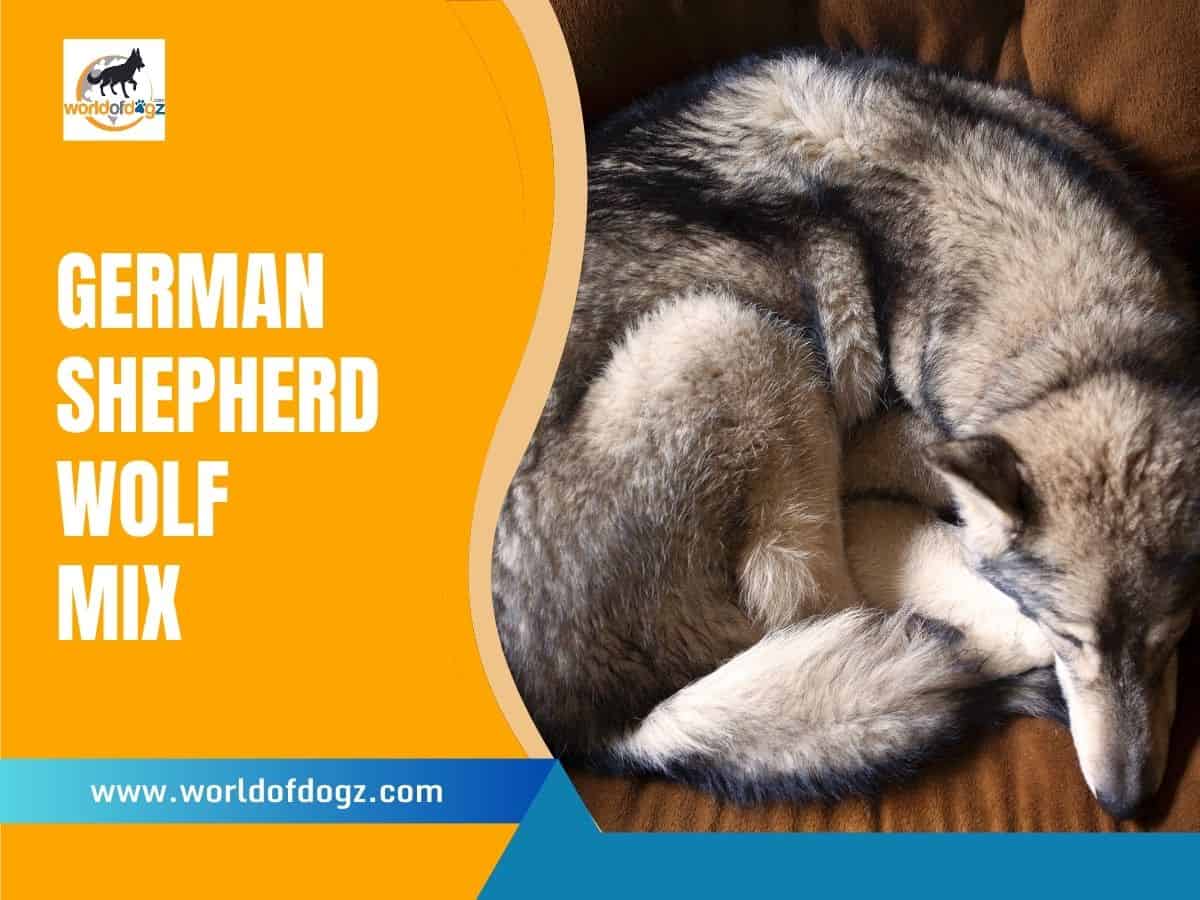
What is a German Shepherd Wolf Mix?
A German Shepherd Wolf Mix is a wolfdog created by mating a German Shepherd Dog (Alsatian Wolf Dog) and a wolf.
Breeding the two canines to create a mix is possible because they belong to the same genus, canis, which is known as intraspecific breeding.
Because the German Shepherd Dog (Canis familiaris) and the Wolf (Canis lupus) belong to the same species, their puppies are fertile hybrids that can interbreed to produce a wolfdog litter.
A fertile litter is not always the case when interbreeding animals of similar species and is impossible with animals of different species.
People might often describe the offspring of a German Shepherd and a wolf as a “wolfdog” or “wolf mix.” The term mix is usually used to underscore the expected improved qualities of the German Shepherd and wolf offspring.
In the dog world, however, hybrid or mix is also used to describe the offspring of purebreds. As such, a German Shepherd Wolf Mix results from mating a purebred German Shepherd and a pure wolf.
Instead, German Shepherd wolfdogs could be any offspring resulting from breeding the following:
- A pure German Shepherd and a pure wolf.
- A pure German Shepherd and a German Shepherd Wolf Mix.
- A pure wolf and a German Shepherd Wolf Mix.
- Two German Shepherd Wolf Mixes (wolf dogs).
Note that the term exotic hybrid is also used in some contexts to describe the offspring of a domestic pet and a similar wild animal species.
With that in mind, let’s explore a bit more the question often asked by curious fans of dog hybrids.
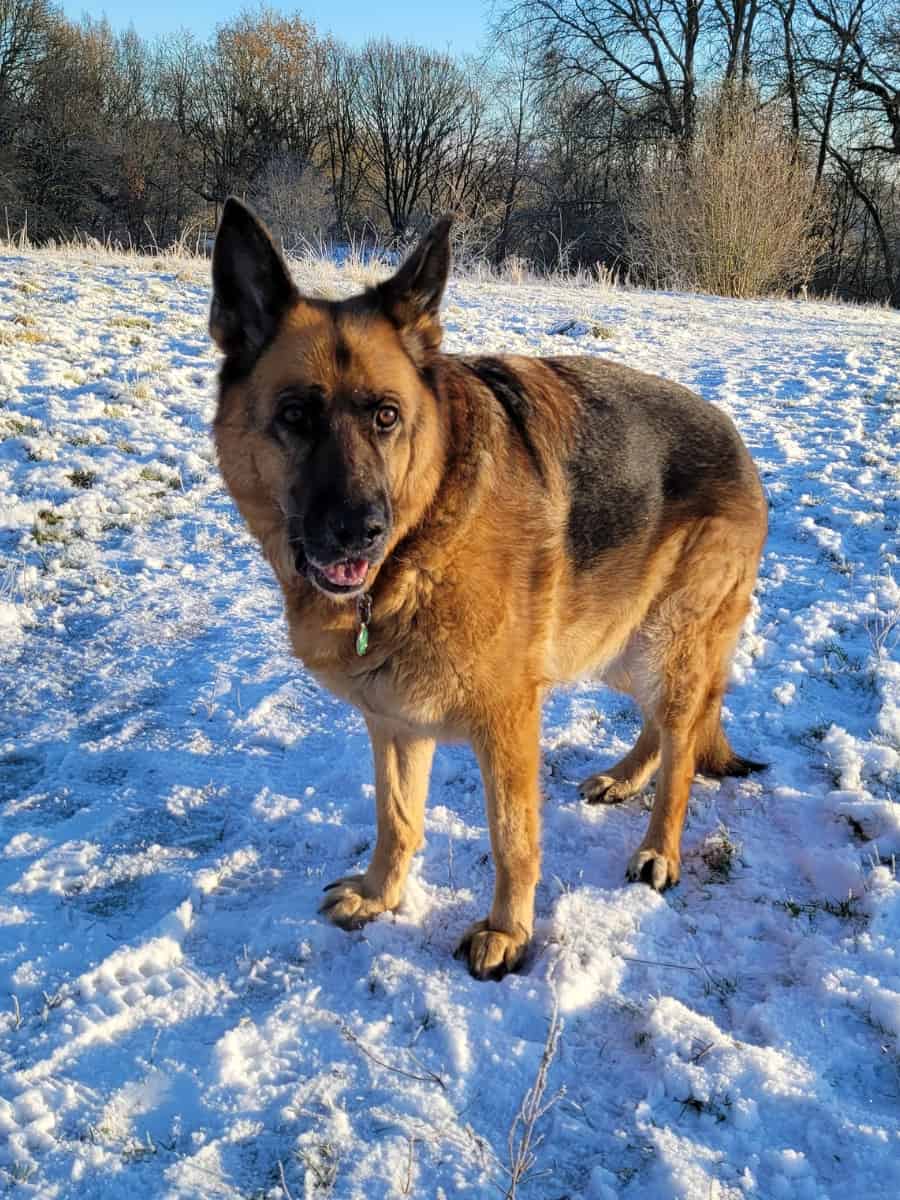
The Science Behind German Shepherd and Wolf Breeding
A German Shepherd can breed with a wolf to create a German Shepherd Wolf Mix. Breeding a German Shepherd and a wolf is viable because the two belong to the same canis species and are genetically closely related.
Some breeders crossed GSDs with wolves many years ago. In fact, the breed is often considered a product of dog-wolf breeding in Germany during the early 20th century.
This explains why German Shepherds look like wolves. When I’m out walking Willow, my German Shepherd, it always makes me laugh when I hear a child say excitedly, “Mom, look at that wolf!”
Also, the Saarloos Wolfdog, which is officially recognized by the United Kennel Club (UKC), results from the breeding of a female European wolf with a German Shepherd male dog in 1932.
The breeder, Leendert Saarloos, consequently bred the offspring to create what we know today as Saarloos Wolfdogs.
The viability of breeding a GSD and a wolf also lies in the fact that a German Shepherd’s (or any dog’s) DNA has a 99% match with that of a gray wolf. They also have the same number of chromosomes (78 chromosomes in 39 pairs).
Because of this genetic closeness, the litter from mating a German Shepherd (Alsatian wolf dog) and a wolf is fertile and will continue to produce wolfdogs.
While dogs and wolves may breed in the wild, this is nearly impossible for the following reasons:
- Wolves are a territorial species that consider other animals in the Canis family to be enemies, especially for food resources.
- Wolves are monogamous and would attack an outsider animal that tries to enter their park to breed. During the breeding season, only the alpha wolves have mating rights.
- Wolves breed only once a year between January and April. A stray dog wandering in the wild has a minimal chance of mating a wolf in the breeding season.
This means that breeding a wolf and a German Shepherd requires human manipulation. However, even though humans may manipulate the mating, they may not control the interaction of genes in the offspring.
These unexpected outcomes often raise the question of whether the German Shepherd Wolf Mix is safe.
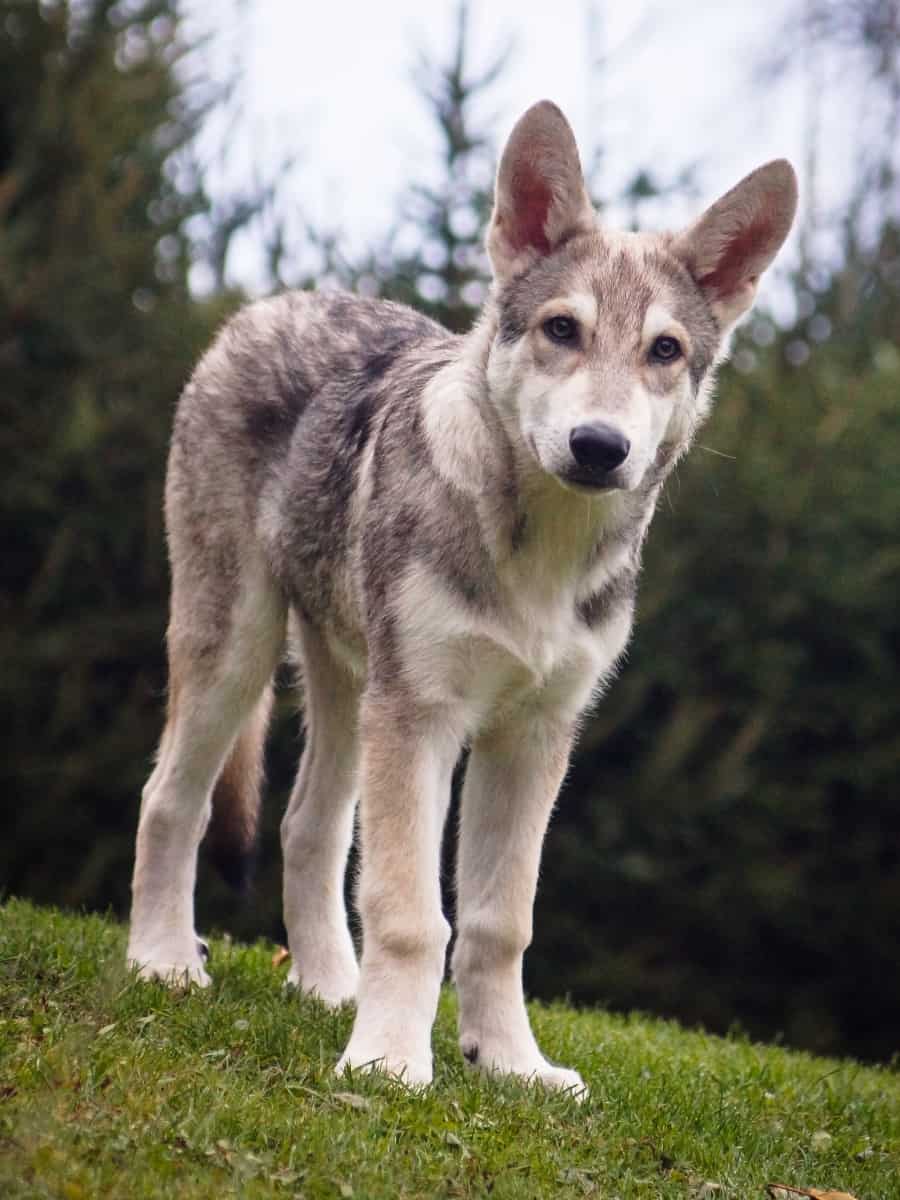
Size & Appearance
As much as you think the German Shepherd Wolf Mix can look majestic, you should also know more about this unique mix in terms of average size, requirements, and some indicators to discover if it’s a proper mix.
When it comes to appearance, a German Shepherd Wolf Mix is a stunning and unique breed that combines the best of both worlds. Here’s what you need to know about their sizes:
| Breed | Height (cm) | Weight (kg) |
|---|---|---|
| German Shepherd | 60-65 | 22-40 |
| Wolf | 66-81 | 30-80 |
| GSD-Wolf Mix | 61-76 | 30-50 |
As you can see, the GSD-Wolf Mix falls somewhere in the middle of its parent breeds in terms of height and weight. While these are generic numbers, they can still give you a better understanding of the ideal size to expect.
Of course, note that your German Shepherd has to be a purebred, and the mating needs professional intervention.
Now that you know about sizes, here are some quick identifiers of a German Shepherd Wolf hybrid:
- Thick, dense fur that’s usually gray or black with brown or white markings
- Pointed ears that stand erect
- A long, bushy tail that curls upwards
- A powerful build with muscular legs and a broad chest
- A wolf-like gait that’s more fluid than a typical German Shepherd’s
- A strong prey drive and high energy level
- A tendency to be independent and stubborn but also loyal to their family
With their combination of strength, agility, and intelligence, they make excellent companions for experienced dog owners who are up for the challenge of training and socializing this one-of-a-kind breed.
Below is a photo of a Czechoslovakian Wolfdog, which was initially bred from working-line German Shepherds and Carpathian grey wolves in 1958.
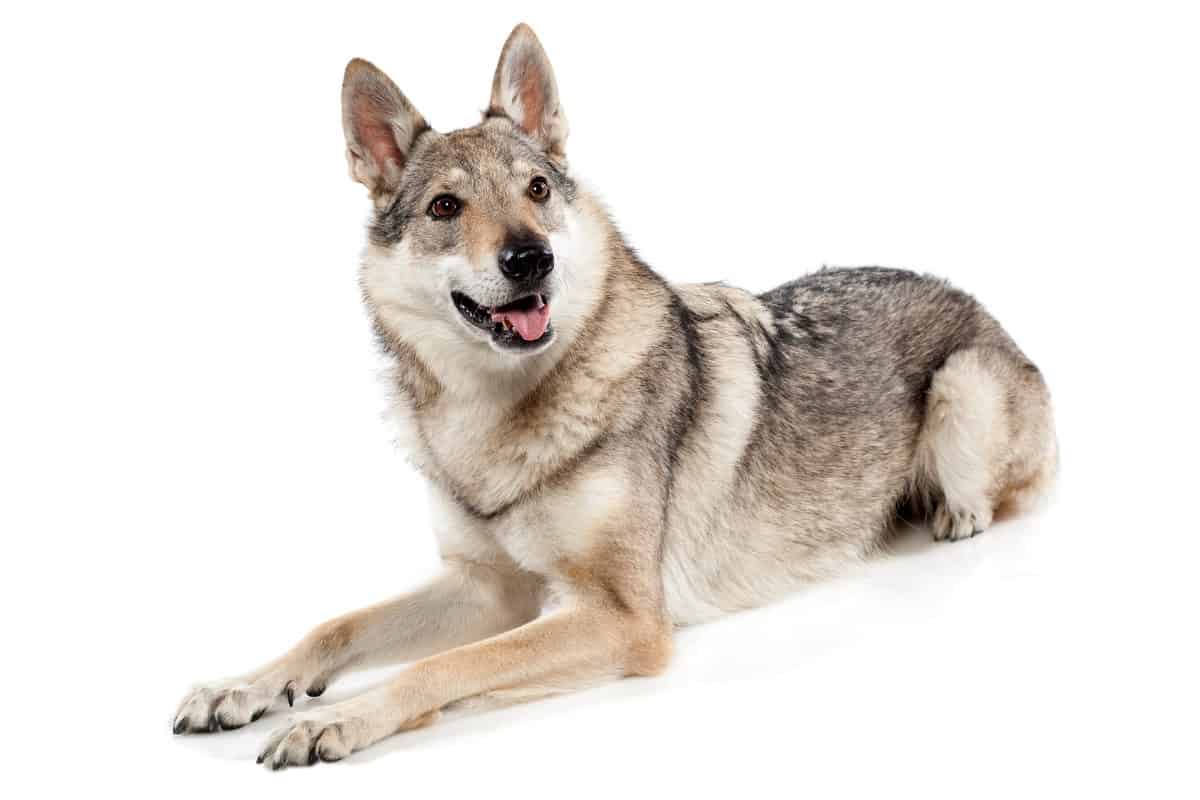
Food & Diet
A German Shepherd Wolf Mix is not your regular crossbreed. This hybrid has a special diet requirement. Unless you know about their unique nutritional needs, you can’t offer justice to petting this majestic mix.
Ideal Diet
Your GSD-Wolf Mix needs a diet that’s high in protein and fat to support its active lifestyle. Look for high-quality dog food that contains real meat as the first ingredient, and avoid fillers like corn, wheat, and soy. Some options include:
- Dry kibble: This is the most common type of dog food and is convenient and easy to store. Look for brands that offer high-quality protein sources like chicken, beef, or fish.
- Wet food: This type of dog food is more palatable than dry kibble and can be a good option for picky eaters. Look for brands that use real meat and avoid fillers.
- Raw food: Some dog owners prefer to feed their GSD-Wolf Mix a raw food diet, which consists of uncooked meat, bones, and organs. This can be a good option for dogs with allergies, but it’s important to consult with your vet and do your research before making the switch.
Common Health Issues
Like all dogs, GSD-Wolf Mixes are prone to certain health issues. But why do I stress it under the diet section?
It’s because the German Shepherd Wolf hybrid is prone to health issues that are related to their nutritional needs. So, you need to know what they’re prone to.
Here’s a brief list.
- Hip dysplasia: This is a genetic condition that affects the hip joint and can cause pain and mobility issues. To help prevent hip dysplasia, make sure your dog maintains a healthy weight and gets regular exercise.
- Digestive issues: Some GSD-Wolf Mixes are prone to digestive issues like bloating, gas, and diarrhea. To help prevent these issues, feed your dog a high-quality diet and avoid table scraps and other human foods.
- Joint problems: Because of their size and activity level, GSD-Wolf Mixes are also prone to joint problems like arthritis. To help support your dog’s joint health, consider adding supplements like glucosamine and chondroitin to their diet.
Supplements
In addition to a well-balanced diet, your GSD-Wolf Mix may benefit from certain supplements. Some options include:
- Fish oil: This supplement contains omega-3 fatty acids, which can help support your dog’s skin and coat health, as well as their joint health.
- Probiotics: These supplements can help support your dog’s digestive health and prevent issues like bloating and diarrhea.
- Multivitamins: A multivitamin supplement can help ensure that your dog is getting all the essential vitamins and minerals they need to stay healthy.
If you’re raising a German Shepherd Wolf Mix, I’d suggest talking to your dog’s dietitian to constantly update their meal plans.
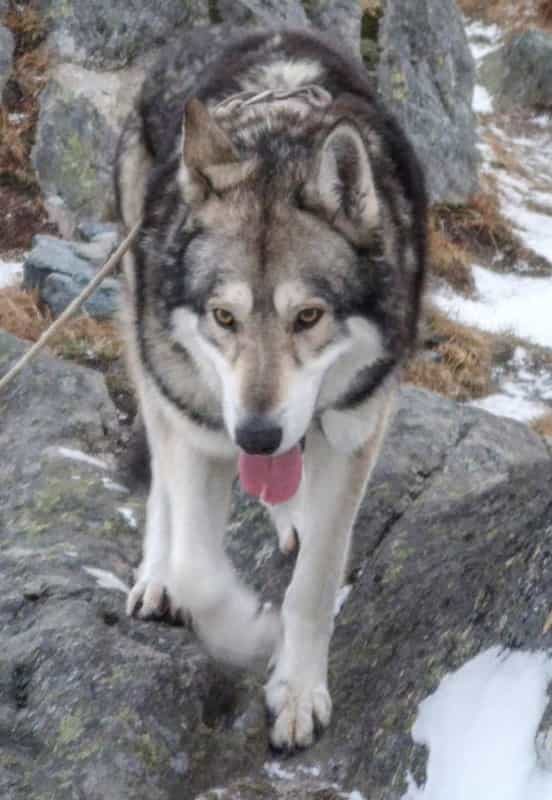
Care & Maintenance
Maintaining a German Shepherd Wolf Mix requires a bit more effort than other breeds due to their unique characteristics. Here are some tips to help you keep your GSD-Wolf hybrid healthy and happy.
I’d like to categorize the maintenance element into several sections, including training, grooming, and exercise, so you get a complete picture of what to expect.
Grooming
Your German Shepherd-Wolf Mix has a thick, dense coat that requires regular grooming to keep it healthy and shiny. Here are some grooming tips to keep in mind:
- Brush their coat at least once a week to remove loose fur and prevent matting.
- Bathe them as needed, but not too often, as it can strip their coat of its natural oils.
- Trim their nails regularly to prevent them from getting too long and causing discomfort.
- Clean their ears regularly to prevent infections.
These are only a few tips.
Ideally, once you get a German Shepherd Wolf Mix, you may encounter new requirements based on their health conditions as well. Nevertheless, regular grooming is mandatory!
Exercise
Your GSD-Wolf Mix is an active breed that needs plenty of exercise to stay healthy and happy. Combining the power and strength of a German Shepherd and a wolf, this mix is inherently stronger. Here are some exercise tips to keep in mind:
- Aim for at least 2 hours of exercise per day, including walks, runs, and playtime.
- Provide plenty of mental stimulation, such as puzzle toys and training sessions.
- Consider enrolling your dog in agility classes or other activities to keep them engaged.
Training
Your GSD-Wolf Mix is a smart and independent breed that needs consistent training and socialization to thrive. In fact, they can understand and grasp commands faster than usual because of their mix.
If you’d like to raise a German Shepherd Wolf hybrid, you should prioritize their physical needs. Here are some training tips to keep in mind:
- Start training and socialization early to prevent behavior issues.
- Use positive reinforcement techniques, such as treats and praise, to encourage good behavior.
- Be patient and consistent in your training approach.
- Consider working with a professional trainer if you need help.
Maintaining a German Shepherd Wolf Mix requires a bit more effort than other breeds, but with the right approach, you can keep your dog healthy and happy for years to come.
By providing them with plenty of exercise, training, and health care, you can enjoy a strong and rewarding bond with your unique and beautiful German Shepherd Wolf Mix.
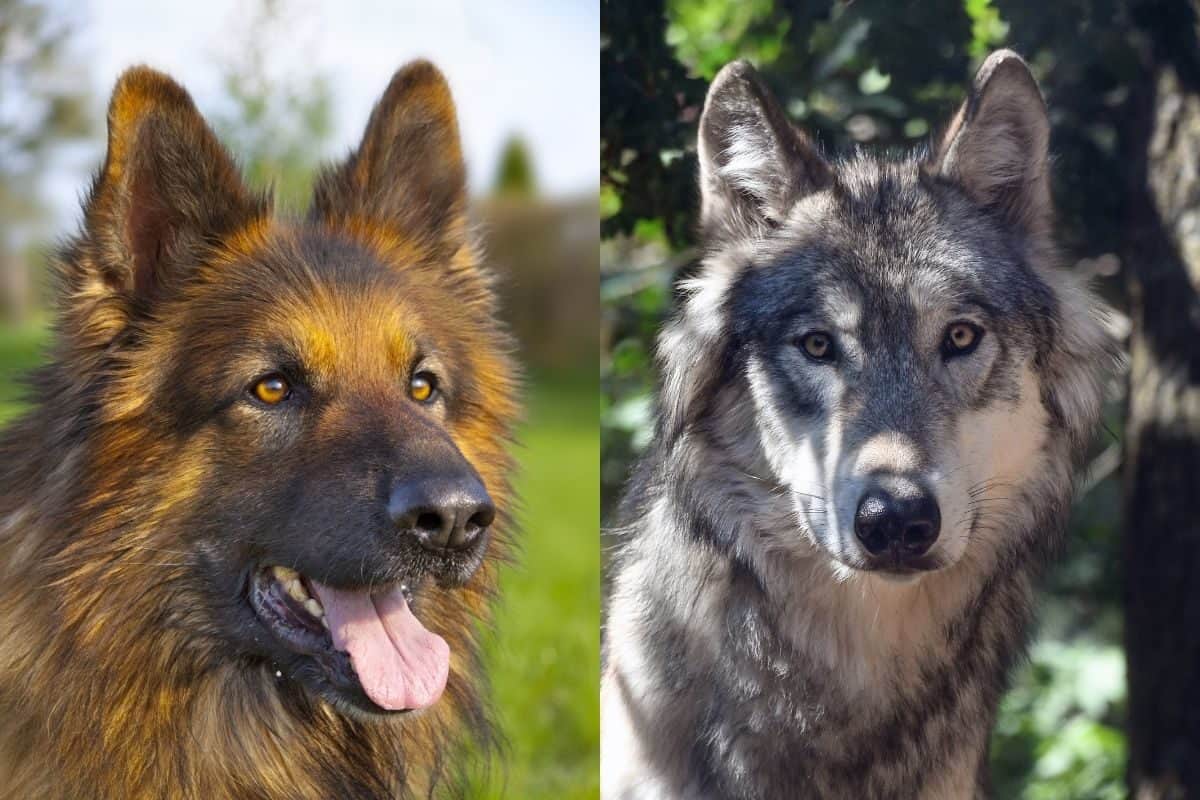
Temperament
The temperament of a German Shepherd Wolf Mix is a unique blend of their parent breeds and can vary depending on their individual genetics and upbringing.
Here’s what you need to know about the typical temperament of a GSD-Wolf Mix:
Your GSD-Wolf Mix is a loyal and devoted companion that will form a strong bond with your family. They have a natural instinct to protect their loved ones and can be fiercely loyal to those they trust.
Your German Shepherd Wolf Mix is a smart and inquisitive breed that thrives on mental stimulation. They are quick learners and respond well to positive reinforcement training techniques.
When we consider their temperament to be wolf-like or dog-like, it’s evident that they carry visible characteristics and are highly active on various fronts (physical, cognitive, and mental).
Similar to their parents, your GSD-Wolf hybrid is an independent breed that can be stubborn at times. They may not always follow commands or listen to their owners and may prefer to do things their own way.
However, this hybrid needs early and consistent socialization to prevent behavior issues. They may be wary of strangers and other animals if they are not properly socialized from a young age.
You must keep them on a leash or in a secure area to prevent them from running off.
Friend or Foe? Assessing the Safety of German Shepherd Wolf Mixes
A German Shepherd Wolf Mix is safe for people professionally trained to handle wolf dogs but is not safe for ordinary pet owners, first-time dog owners, and families with children.
Three primary reasons move people to interbreed wolves and German Shepherds or any other dog breed:
- The desire to create the attractive wolf look in a wolfdog.
- The expectation is that breeding a German Shepherd and a wolf will produce an exceptionally hybrid pup with a balanced blend of the domestic and the wild traits in the two canines.
- The attempt to tame the wild in the wolf and create a fiercer guard dog than the purebred German Shepherd.
Unfortunately, these expectations rarely materialize. Instead, German Shepherd Wolf hybrids can manifest extreme aggression and stubbornness for several reasons.
Let’s take a look at them now.
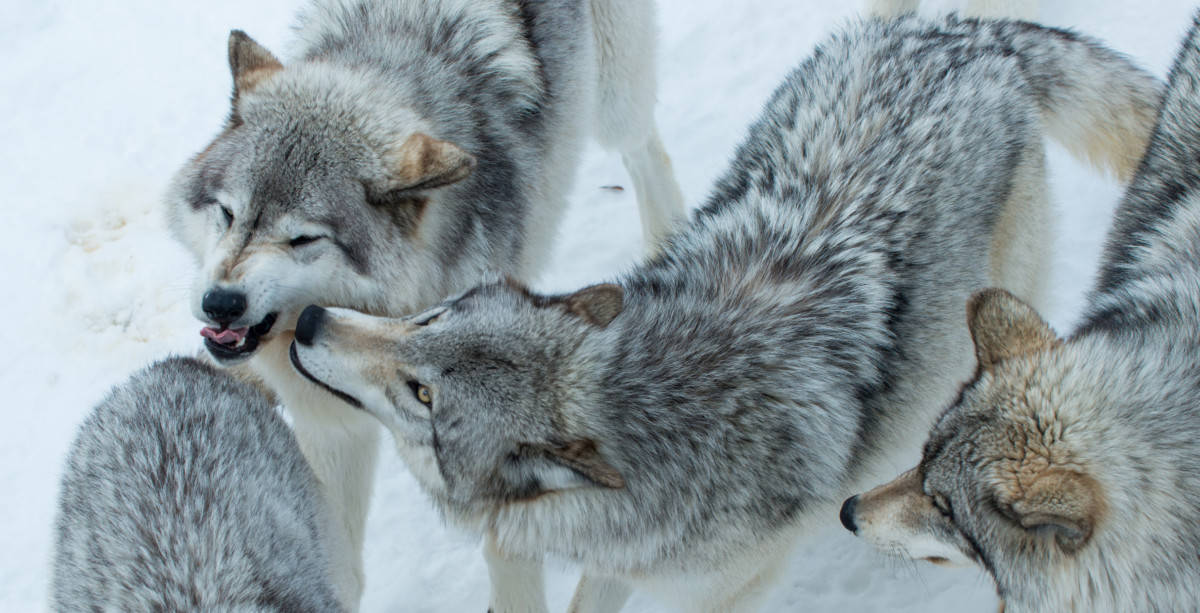
Uncontrolled Sexual Maturity Changes
Wolves and dogs mature at different rates.
Dogs sexually mature by 6 to 8 months, but they also have less aggressive hormonal changes and a more stable behavioral pattern in the years of sexual maturity.
In contrast, wolves only mature sexually at around 1 to 4 years.
The species-specific roles that come with sexual maturity, such as fighting their place in pack roles, can generate aggression and stubbornness and make their behavior patterns extremely unpredictable.
Inheriting the unpredictable behavior of a wolf can make German Shepherd Wolf Mixes challenging to manage. And pruning out the wolf traits in the Wolf Shepherd can be tricky, even with training.
That means having to deal with a difficult-to-manage pet.
A Wild Prey Drive
Prey drive is the instinctive tendency of carnivores to pursue and capture prey, also known as predatory behavior.
It is not necessarily accompanied by aggression, but it can make these animals hunt other smaller animals or livestock when they shouldn’t.
Both the wolf and the German Shepherd have a strong prey drive, the first more than the second.
This behavior can make your wolfdog threaten the safety of livestock and other animals when you walk with them or even try to escape to meet this instinctual hunting drive.
Territoriality
Wolves are a territorial species, a trait that German Shepherd Wolf Mixes can inherit. Wolfdogs often show territoriality through urine marking.
But being territorial especially means that the wolfdog will be possessive of things and spaces in the home.
As a result, the Wolf Shepherd will tend to be aggressive and defensive when other animals and people approach areas and things they consider to belong to them.
Winter Wolf Syndrome
Winter wolf syndrome, or seasonal aggression, is the aggression that characterizes wolves and wolfdogs around the mating season.
It is linked to hormonal fluctuations during the wolf’s breeding cycle and is even notable in neutered or spayed wolves and wolfdogs, meaning it’s a natural species behavior.
The manifestation of the winter wolf syndrome can vary from wolf to wolf or wolfdog to wolfdog.
Some wolves and wolf dogs may just show a bit of grumpiness, while others can show outright aggressiveness and extreme possessiveness.
In German Shepherd Wolf hybrids and other wolfdogs, the extent of the winter wolf syndrome behaviors may vary with:
- Wolf content: The amount of wolf in a German Shepherd Dog.
- Sex: Males show protective behavior towards females, and females may show aggression towards their fellow females. In both cases, the wolfdogs can direct this aggression toward the owner or other persons.
According to the Colorado Wolf Sanctuary, because of the natural element in the winter wolf syndrome, wolves and wolfdog owners should be aware that it is unsafe to interact directly with their pets in the five months or more around the mating season.
The resulting question from the discovery that wolfdogs can be unsafe is whether governments allow people to own wolfdogs, even though they can turn violent.
Learn More About The German Shepherd Wolf Mix…
Legalities of Owning a German Shepherd Wolf Mix
Whether it is legal to own a GSD Wolf Mix greatly depends on the laws of each state or country. In some states, owning a wolfdog is illegal.
Others regulate the ownership of wolfdogs with the same laws set for the ownership of wild animals, while others regulate wolfdogs in the same way as dogs.
When owning a wolfdog is permitted by law, some states and local laws may specify the permissible wolf content in the wolfdog or require owners to get additional permits.
According to the Legal Wolf Dog Ownership Map on the Colorado Wolf Sanctuary:
- Most states in the US, like Washington, Oregon, Colorado, and New Mexico, have local restrictions on wolfdog ownership.
- A good number of states, including California, Montana, Idaho, and Florida, have both local and state restrictions on wolfdog ownership.
- Fewer states like Alaska, Georgia, Michigan, and Illinois completely outlaw wolfdogs.
- No state in the US is without restrictions on wolfdog ownership.
As laws are constantly changing, please contact your city, county, and state governments before purchasing a wolf dog.
In other countries like the UK, you require a license to own first-generation (F1) wolf dogs, which are regulated by the Dangerous Wild Animals Act 1976. However, it is legal to own a wolfdog as long as it is 3 generations (F3) from the parent wolf.
In other words, you can own a German Shepherd wolfdog if it is born of second-generation wolfdogs or a second-generation wolfdog and a German Shepherd.
Final Thoughts
A German Shepherd Wolf Mix is a strong, majestic crossbreed that isn’t widely found in the market.
With this exception, there’s also the problem of temperament and high energy levels that tend to mismatch with typical attributes expected from a pet dog.
Going forward, you should check the safety and legality associated with the mix before you decide to get one. Even if you possess adequate knowledge in raising one, this hybrid is pretty challenging and can pose complexities on the go.
Related Posts You May Like:





